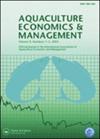混合logit和潜在类模型的比较,以估计面临海洋酸化的海产品市场细分
IF 3.7
2区 经济学
Q1 AGRICULTURAL ECONOMICS & POLICY
引用次数: 1
摘要
摘要本研究采用选择实验方法,基于受海洋酸化影响的海鲜(贻贝)的三个属性:外壳外观、肉色和营养成分,来表征市场细分(消费者偏好异质性)。使用来自智利两个主要城市的1,257个人的样本,我们估计了混合Logit模型和潜在类别模型。我们使用个体特定后验(ISP)参数的分布,根据这些ISP的标志和强度(即喜欢或不喜欢的维度)对消费者的异质性进行分类。我们比较了偏好的模式,以及在两个模型中人们是否属于相同的偏好模式。总的来说,我们观察到,这些模型确定了不同数量的具有不同偏好模式的细分市场。此外,这些模型将同一个人分为不同的组。由于分割对所选择的模型很敏感,我们讨论了在选择实验和未来海洋酸化条件下建立市场细分的方法方法的优势、不一致、偏差和最佳实践。本文章由计算机程序翻译,如有差异,请以英文原文为准。
A comparison of mixed logit and latent class models to estimate market segments for seafood faced with ocean acidification
Abstract This study uses a choice experiment to characterize market segments (consumer preferences heterogeneity) based on three attributes of seafood (mussels) that are affected by ocean acidification: shell appearance, meat color, and nutritional composition. Using a sample of 1,257 individuals from two main cities in Chile, we estimate both the Mixed Logit model and the Latent Class model. We use the individual-specific posterior (ISP) parameters’ distribution to categorize consumers’ heterogeneity based on the signs and intensity (i.e., like or dislike dimension) of these ISPs. We compare the pattern of preferences and whether people are classified within the same preference pattern in both models. In general, we observed that the models identify a different number of segments with various patterns of preferences. Moreover, the models classify the same people into different groups. Since the segmentation is sensitive to the chosen model, we discuss strengths, inconsistencies, biases, and best practices regarding methodological approaches to establishing market segments in choice experiments and future ocean acidification conditions.
求助全文
通过发布文献求助,成功后即可免费获取论文全文。
去求助
来源期刊

Aquaculture Economics & Management
FISHERIES-
CiteScore
7.30
自引率
17.90%
发文量
21
期刊介绍:
Aquaculture Economics and Management is a peer-reviewed, international journal which aims to encourage the application of economic analysis to the management, modeling, and planning of aquaculture in public and private sectors. The journal publishes original, high quality papers related to all aspects of aquaculture economics and management including aquaculture production and farm management, innovation and technology adoption, processing and distribution, marketing, consumer behavior and pricing, international trade, policy analysis, and the role of aquaculture in food security, livelihoods, and environmental management. Papers are peer reviewed and evaluated for their scientific merits and contributions.
 求助内容:
求助内容: 应助结果提醒方式:
应助结果提醒方式:


